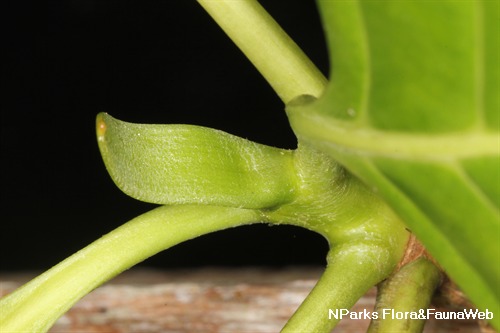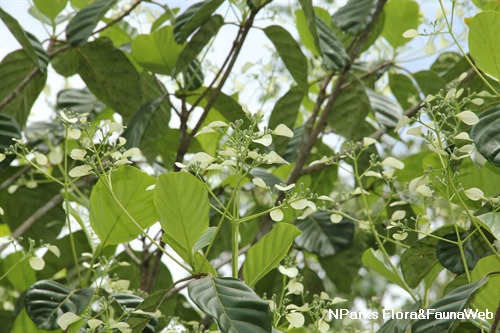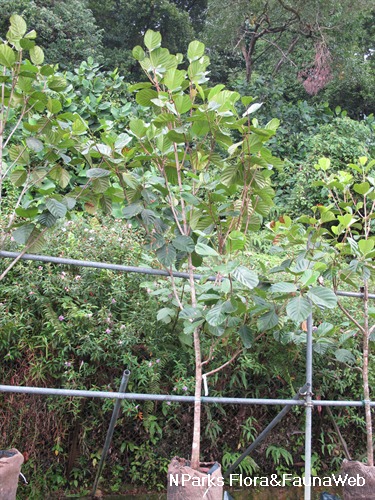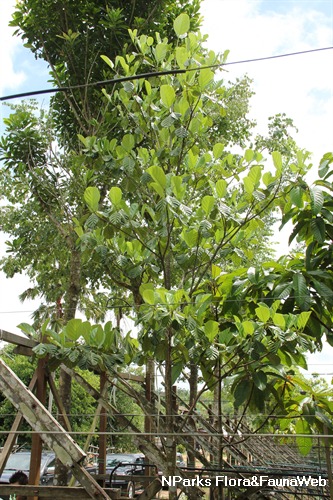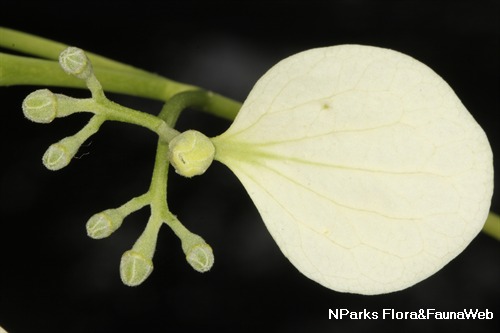
Back
Mussaendopsis beccariana Baill.
| Family Name: | Rubiaceae |
| Common Name: | Malabera Bukit, Melabira Bukit, Selumar |
Name
Classifications and Characteristics
| Plant Division | Angiosperms (Flowering Seed Plants) (Dicotyledon) |
|---|---|
| Plant Growth Form | Tree (Big (>30m)) |
| Lifespan (in Singapore) | Perennial |
| Mode of Nutrition | Autotrophic |
| Plant Shape | Irregular |
| Maximum Height | 35 m |
Biogeography
| Native Distribution | Sumatra, Peninsular Malaysia, Singapore, and Borneo |
|---|---|
| Native Habitat | Terrestrial (Primary Rainforest, Freshwater Swamp Forest) |
| Preferred Climate Zone | Tropical |
| Local Conservation Status | Native to Singapore (Critically Endangered (CR)) |
Description and Ethnobotany
| Growth Form | It is a tree up to 35 m tall. It has buttress roots up to 2 m tall, and sometimes stilt roots. Its bark is smooth and grey-brown. |
|---|---|
| Foliage | Its opposite, stalked leaves have leathery blades that are usually slightly round to broadly elliptic, dark green above, green below, 8–22 by 6–20 cm, and have 6–8 pairs of yellow, parallel veins. |
| Flowers | Its clustered flowers are white, densely covered with yellow hair outside, with one sepal enlarged to a drop-shaped pale yellow wing. |
| Fruit | Its capsule fruit is drop-shaped, dark brown when mature, 2 by 0.5 cm, and splits into 2 from the apex downwards to disperse its seeds. Its seed is ellipsoid, 2–4 mm long, and has a narrow wing. |
| Habitat | It grows in inland forests. It occurs locally in Nee Soon Swamp Forest. |
| Associated Fauna | Its flowers are pollinated by birds. |
| Cultivation | It can be propagated by seed. |
| Etymology | Latin Mussaendopsis, resembling Mussaenda; Latin beccariana, commemorating Odoardo Beccari (1843–1920), botanist and traveller in Borneo |
| Ethnobotanical Uses | Timber & Products: The hard, durable timber is used for construction and boat-building. |
Landscaping Features
| Landscaping | It is suitable for parks for its attractive flowers and strong hard wood. |
|---|---|
| Desirable Plant Features | Ornamental Flowers |
| Landscape Uses | Parks & Gardens |
Fauna, Pollination and Dispersal
| Fauna Pollination Dispersal Associated Fauna | Bird-Attracting (Flowers) |
|---|---|
| Pollination Method(s) | Biotic (Fauna) (Vertebrates (Bird)) |
| Seed or Spore Dispersal | Abiotic |
Plant Care and Propagation
| Light Preference | Full Sun, Semi-Shade |
|---|---|
| Water Preference | Moderate Water |
| Plant Growth Rate | Moderate |
| Rootzone Tolerance | Moist Soils, Well-Drained Soils, Fertile Loamy Soils |
| Propagation Method | Seed |
Foliar
| Foliage Retention | Evergreen |
|---|---|
| Mature Foliage Colour(s) | Green |
| Mature Foliage Texture(s) | Leathery |
| Foliar Type | Simple / Unifoliate |
| Foliar Arrangement Along Stem | Opposite |
| Foliar Attachment to Stem | Petiolate |
| Foliar Shape(s) | Non-Palm Foliage (Elliptical, Orbicular / Round) |
| Foliar Venation | Pinnate / Net |
| Foliar Margin | Entire |
Floral (Angiosperm)
| Flower & Plant Sexuality | Bisexual Flowers |
| Flower Colour(s) | White, Yellow / Golden |
|---|---|
| Flower Texture(s) | Hairy / Hirsute |
| Flower Grouping | Cluster / Inflorescence |
| Flower Location | Axillary |
| Flower Symmetry | Radial |
Fruit, Seed and Spore
| Mature Fruit Colour(s) | Brown |
|---|---|
| Fruit Classification | Simple Fruit |
| Fruit Type | Dehiscent Dry Fruit , Capsule |
Image Repository
Others
| Master ID | 30947 |
|---|---|
| Species ID | 5333 |
| Flora Disclaimer | The information in this website has been compiled from reliable sources, such as reference works on medicinal plants. It is not a substitute for medical advice or treatment and NParks does not purport to provide any medical advice. Readers should always consult his/her physician before using or consuming a plant for medicinal purposes. |

